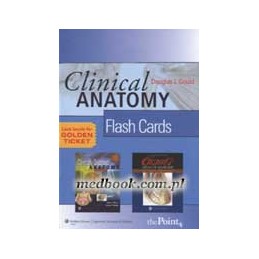- Obniżka


 Dostawa
Dostawa
Wybierz Paczkomat Inpost, Orlen Paczkę, DHL, DPD, Pocztę, email (dla ebooków). Kliknij po więcej
 Płatność
Płatność
Zapłać szybkim przelewem, kartą płatniczą lub za pobraniem. Kliknij po więcej szczegółów
 Zwroty
Zwroty
Jeżeli jesteś konsumentem możesz zwrócić towar w ciągu 14 dni*. Kliknij po więcej szczegółów
This clinically relevant anatomy flash card set is based on the concepts and full-color images in Moore and Dalleys Clinically Oriented Anatomy, Fifth Edition and Agur and Dalleys Grants Atlas of Anatomy, Eleventh Edition. The card set is a convenient, flexible, portable, practical study and review tool for gross anatomy courses, USMLE Step 1 preparation, clinical anatomy review during clerkships, and for dental and allied health students.
Organized and color-coded using the regional approach of Clinically Oriented Anatomy, the cards feature clinically relevant descriptions of structures, concise versions of the texts clinical Blue Boxes, and correlating images. Realistic anatomic renderings from Grants Atlas complement this clinically oriented material.
Opis
Clinical Anatomy Flash Cards were created to serve as the premier ancillary learning resource for the study of clinically relevant anatomy.
The cards are designed for use by all undergraduate, graduate, and professional level students of anatomy; surgical residents; and practicing clinicians in need of a comprehensive review. The flash cards are organized around the popular blue boxes from Clinically Oriented Anatomy, 5th Edition, by Moore and Dalley, and they feature artwork from Grants Atlas of Anatomy, 11th Edition, by Agur and Dalley
The front of each card features an image fromGrants Atlas-the finest collection of anatomy images available-with 5 to 10 structures indicated for identification; the answers are provided on the back of the card. Approximately 150 muscles are labeled with red numbers on the front of the cards with corresponding attachment, innervation, and action information detailed on the back. Clinically relevant blue boxes,modified from Clinically Oriented Anatomy, appear on the back of most cards and serve to reinforce the anatomy pictured on the front. Approximately 90 per cent of the blue box topics from Clinically Oriented Anatomy are covered in this set.
Thorax
Abdomen
Pelvis and Perineum
Back
Lower Limb
Upper Limb
Head
Neck
Cranial Nerves
